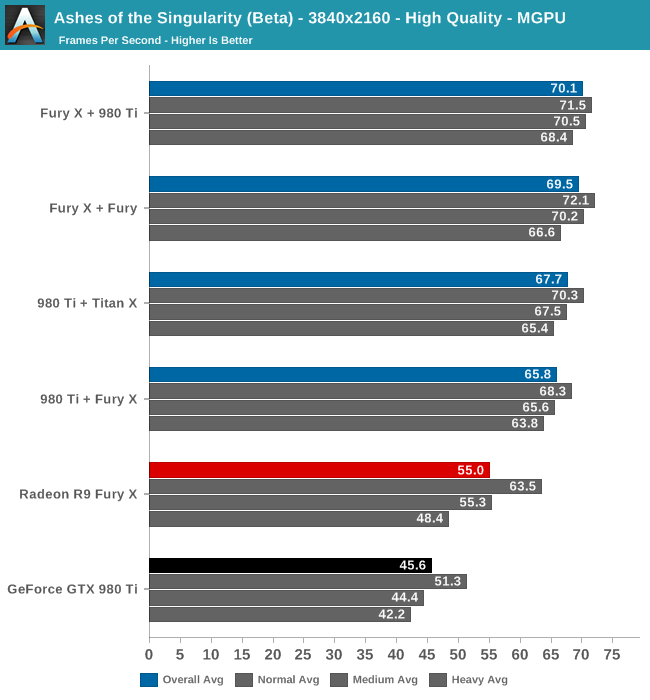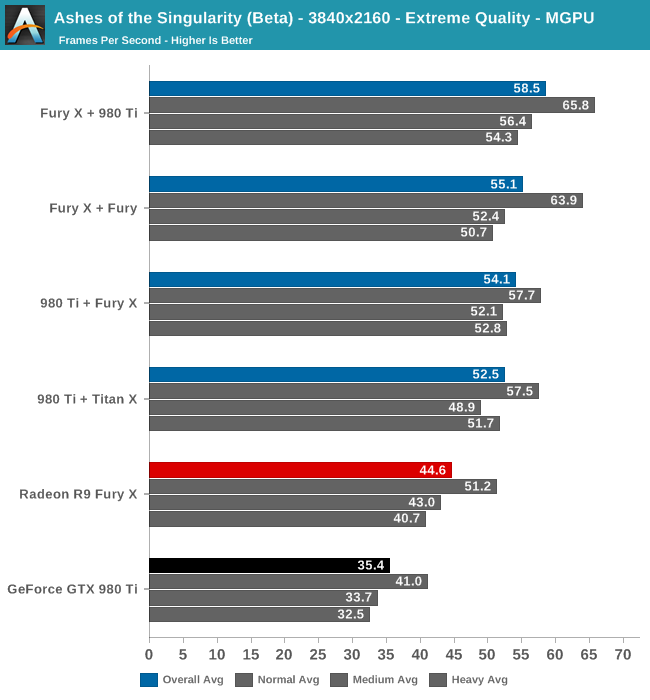Ashes of the Singularity Revisited: A Beta Look at DirectX 12 & Asynchronous Shading
by Daniel Williams & Ryan Smith on February 24, 2016 1:00 PM ESTDirectX 12 Multi-GPU Performance
Shifting gears, let’s take a look at multi-GPU performance on the latest Ashes beta. The focus of our previous article, Ashes’ support for DX12 explicit multi-GPU makes it the first game to support the ability to pair up RTG and NVIDIA GPUs in an AFR setup. Like traditional same-vendor AFR configurations, Ashes’ AFR setup works best when both GPUs are similar in performance, so although this technology does allow for some unusual cross-vendor comparisons, it does not (yet) benefit from pairing up GPUs that widely differ in performance, such as a last-generation video card with a current-generation video card. None the less, running a Radeon and a GeForce card together is an interesting sight, if only for the sheer audacity of it.
Meanwhile as a result of the significant performance optimizations between the last beta build and this latest build, this has also had an equally significant knock-on effect on mutli-GPU performance as compared to the last time we looked at the game.

Even at 4K a pair of GPUs ends up being almost too much at Ashes’ High quality setting. All four multi-GPU configurations are over 60fps, with the fastest Fury X + 980 Ti configuration nudging past 70fps. Meanwhile the lead over our two fastest single-GPU configurations is not especially great, particularly compared to the Fury X, with the Fury X + 980 Ti configuration only coming in 15fps (27%) faster than a single GPU. The all-NVIDIA comparison does fare better in this regard, but only because of GTX 980 Ti’s lower initial performance.
Digging deeper, what we find is that even at 4K we’re actually CPU limited according to the benchmark data. Across all four multi-GPU configurations, our hex-core overclocked Core i7-4960X can only setup frames at roughly 70fps, versus 100fps+ for a single-GPU configuration.

Top: Fury X. Bottom: Fury X + 980 Ti
The increased CPU load from utilizing multi-GPU is to be expected, as the CPU now needs to spend time synchronizing the GPUs and waiting on them to transfer data between each other. However dropping to 70fps means that Ashes has become a surprisingly heavy CPU test as well, and that 4K at high quality alone isn’t enough to max out our dual GPU configurations.

Cranking up the quality setting to Extreme finally gives our dual-GPU configurations enough of a workload to back off from the CPU performance cap. Once again the fastest configuration is the Fury X + 980 Ti, which lands just short of 60fps, followed by the Fury X + Fury configuration at 55.1fps. In our first look at Ashes multi-GPU scaling we found that having a Fury X card as the lead card resulted in better performance, and this has not changed for the newest beta. The Fury continues to be faster at reading data off of other cards. Still, the gap between the Fury X + 980 Ti configuration and the 980 Ti + Fury X configuration has closed some as compared to last time, and now stands at 11%.
Backing off from the CPU limit has also put the multi-GPU configurations well ahead of the single-GPU configurations. We’re now looking at upwards of a 65% performance boost versus a single GTX 980, and a smaller 31% performance boost versus a single Fury X. These are smaller gains for multi-GPU configurations than we first saw last year, but it’s also very much a consequence of Ashes’ improved performance across the board. Though we didn’t have time to test it, Ashes does have one higher quality setting – Crazy – which may drive a bit of a larger wedge between the multi-GPU configurations and the Fury X, though the overhead of synchronization will always present a roadblock.












153 Comments
View All Comments
knightspawn1138 - Thursday, February 25, 2016 - link
I think that Radeon's advantage in DX12 comes from the fact that most of DX12's new features were similar to features AMD wrote into the Mantle API. They've been designing their recent cards to take advantage of the features they built for Mantle, and now that DX12 includes many of those features, their cards essentially get a head-start in optimization.If Radeon and NVidia were running a 100-yard dash, it just means that Radeon's starting block is about 5-yards ahead of NVidia's. I (personally) think that NVidia's still the stronger runner, and they easily have the potential to catch up to Radeon's head start if they optimize their drivers some more. And, honestly, a 4fps gap should not be enough of a reason to walk away from whichever brand you already prefer.
I still prefer NVidia due to the lower power consumption, friendlier drivers, 3D glasses, and game streaming they've had for a few years. I used to like ATI cards, but when the Catalyst Control Center started sucking more cycles out of my CPU than the 3D games, I switched to NVidia.
I would also like to have seen the GTX 970 in some of these benchmarks. I understand benchmarking the highest-end cards, but I hope that when the game is out of beta and being used as an official DX12 benchmark, we get some numbers from the more affordable cards.
Shadowmaster625 - Thursday, February 25, 2016 - link
Of course Nvidia's performance doesnt go up under DX12. That is no doubt intentional. Why would they improve their current cards when they can sell all new ones to the same gullible fools that fell for that trick the last time around?Denithor - Thursday, February 25, 2016 - link
I had exactly the same thought. AMD may have shot themselves in the foot. Everyone using their cards is going to see a 10-20% boost in performance, meaning they may not need an upgrade this cycle.silverblue - Thursday, February 25, 2016 - link
Perhaps, but DX12's lower overhead would just encourage devs to make even more complex scenes. Result: same performance, better visuals.All the people jumping on NVIDIA need to be careful, as there's parts of the DX12 spec that they support better than AMD. Give it a year to eighteen months and we'll see how this pans out.
K_Space - Sunday, February 28, 2016 - link
Having read all 13 pages of comments I was surprised no one mentioned this either. I'll certainly be keeping my 295x2 for at least the next 18 months if not 24 months. With AFR and VR coming up, Dual GPUs is the way to go.Drake O - Thursday, February 25, 2016 - link
I was really hoping to see the benefits of sharing workload with the iGPU. Not everyone has multiple GPUs(but I do) but most people have a CPU with onboard graphics. If people with graphics cards can finally start using this recourse that would be a very good thing for a tremendous number of users. Please follow this article up as soon as possible with one on this area. Maybe one percent of users have different brand video cards laying around, maybe five percent have multiple similar GPUs but almost everyone has a video card and an unused iGPU on their CPU. This is the obvious first direction to take.rhysiam - Thursday, February 25, 2016 - link
This is (sort of) covered in the article and covered clearly in the comments above. This particular game is only using AFR, and the devs have clearly said (as noted in the article) that you'll never get more than double the performance of the slower graphics solution. Just about any discrete GPU worth of the name will be more than double the performance of an IGP and therefore is better (for this game) run on its own.DX12 opens up a raft of possibilities to use any and all available graphics resources, including IGPs, but it leaves the responsibility entirely with the game developers. For this game at this time, the devs aren't looking to make use of onboard graphics unless it's paired with a similarly anaemic GPU.
Drake O - Thursday, February 25, 2016 - link
If virtually everyone can boost their framerate by 20% at no cost then it is a big thing. Most people want one processor and one video card. Multiple video cards offer a very real performance boost but there is a downside, more power, more heat and frequent compatibility issues. With DX12 developers can send the post processing to the iGPU and let the video card handle the rest. Again a 20% performance boost for free. Only then should you think about the much smaller market that wants to run with multiple video cards.Kouin325 - Friday, February 26, 2016 - link
yes indeed they will be patching DX12 into the game, AFTER all the PR damage from the low benchmark scores is done. Nvidia waved some cash at the publisher/dev to make it a gameworks title, make it DX11, and to lock AMD out of making a day 1 patch.This was done to keep the general gaming public from learning that the Nvidia performance crown will all but disappear or worse under DX12. So they can keep selling their cards like hotcakes for another month or two.
Also, Xbox hasn't been moved over to DX12 proper YET, but the DX11.x that the Xbox one has always used is by far closer to DX12 than DX11 for the PC. I think we'll know for sure what the game was developed for after the patch comes out. If the game gets a big performance increase after the DX12 patch then it was developed for DX12, and NV possibly had a hand in the DX11 for PC release. If the increase is small then it was developed for DX11,
Reason being that getting the true performance of DX12 takes a major refactor of how assets are handled and pretty major changes to the rendering pipeline. Things that CANNOT be done in a month or two or how long this patch is taking to come out after release.
Saying "we support DirectX12" is fairly ease and only takes changing a few lines of code, but you won't get the performance increases that DX12 can bring.
Kouin325 - Friday, February 26, 2016 - link
yes indeed they will be patching DX12 into the game, AFTER all the PR damage from the low benchmark scores is done. Nvidia waved some cash at the publisher/dev to make it a gameworks title, make it DX11, and to lock AMD out of making a day 1 patch.This was done to keep the general gaming public from learning that the Nvidia performance crown will all but disappear or worse under DX12. So they can keep selling their cards like hotcakes for another month or two.
Also, Xbox hasn't been moved over to DX12 proper YET, but the DX11.x that the Xbox one has always used is by far closer to DX12 than DX11 for the PC. I think we'll know for sure what the game was developed for after the patch comes out. If the game gets a big performance increase after the DX12 patch then it was developed for DX12, and NV possibly had a hand in the DX11 for PC release. If the increase is small then it was developed for DX11,
Reason being that getting the true performance of DX12 takes a major refactor of how assets are handled and pretty major changes to the rendering pipeline. Things that CANNOT be done in a month or two or how long this patch is taking to come out after release.
Saying "we support DirectX12" is fairly ease and only takes changing a few lines of code, but you won't get the performance increases that DX12 can bring.